| BACK to Chapter III Index | | | PLATES for this Case |
A black ring that became obscured by an opaque white cloud, reportedly witnessed by about 15 persons and photographed by the principal witness, is identified as the by-product of an "atom bomb simulation demonstration" on the army base.
Background:
Time: Approx. 9 a.m.
Position: Looking NNE past building T741, Fort Belvoir, Va.
Terrain: Gently rolling hills with scattered technical buildings, residential areas, and woods.
Weather Conditions: Exact date unknown; hence weather conditions unavailable. Photographs show scattered cloud cover.
Sighting, General Information:
Private X, who worked as a draftsman with Post Engineers (1), has given the following account of the visual and photographic sighting. He was in one of several buildings facing on a parking lot flanked by buildings T741 and T742 (1, 3). Someone from the outside called for the men to come out and see the curious object approaching overhead. Pvt. X and several others came out in time to see a dark, ringshaped object approaching in the north. He ran to his car in the parking lot and got his Kodak Brownie camera (1, 2, 5).
Pvt. X thought the black ring "seemed solid," as opposed to being "like smoke" (2), although he also stated that it was not metallic, shiny, or dull, but very black with no reflection (1).
The duration of the sighting was estimated at not more than five
minutes (1), with perhaps 30 - 60 sec. required for the black ring to
become enveloped by smoke.
Roughly 15 men saw the phenomenon, and at least two photographed it
(1). Pvt. X did not know any of these men personally, as he had
recently been assigned to work in this building. Efforts to locate
other witnesses were unsuccessful. After watching the cloud for a
while, the men returned inside without waiting to see what became of
it. There was a feeling at this time that perhaps the object
represented some kind of secret test (1, 2, 5).
Investigation:
Pvt. X believed that the object was connected with some sort of test
or experiment and that it perhaps should not have been photographed.
As a result he made no inquiry or report at Fort Belvoir and did not
have his photographs developed until a month after the incident when
he had returned home (1, 2, 5). He notes, "I was only a private in the
Army...the only thing mentioned was that it was strange and maybe
someone was experimenting so we didn't tell anybody that we even took
these pictures...I didn't want to get in trouble so when I came home
I had the pictures developed then" (2).
With regard to the sighting Pvt. X has been an intelligent and
interested advisor. His suggestions for locating other witnesses
indicated a sincere attempt to be helpful in shedding light on the
affair.
Photographic analysis. A preliminary analysis was carried out on
this case on the basis of which it was regarded by us as potentially
interesting. The early tests are briefly described as examples of the
kind of analysis which allowed us to classify UFO reports as
potentially important, verifiable, and/or explicable.
Consistency with observer's report. The photographs all overlap
on a large tree whose complex foliage shows no parallax whatsoever
verifying Pvt. X's statement that all photographs were taken from one
spot. This was later determined to be in the middle of the parking
lot near Pvt. X's building. By overlapping and "blinking" the six
exposures, motions of the background clouds could be followed from
Plates 34-37. The numbering of the photographs was found to be
consistent with the motion of the clouds. A montage showing the
object and cloud motions in the six frames is shown in Fig. 5 . it is
significant that the relative spacings of both UFO and cloud
positions are the same; this is an argument against a fabrication
created by sketching an object on six photographs, because such a
fabrication would require a certain sophistication on the part of the
artist.
Geometric and physical tests; Inclination vs. altitude. If a
flat disk or ring moves with its plane parallel to the ground (the
mode of flight usually associated with "flying saucers"), the
observed inclination angle (observer-center-rim) should equal the
observed altitude. One initial hypothesis was that these photos could
represent optical fabrication with an image drawn in on photographs
made earlier. It was important to test the geometric consistency of
the images with tests more sophisticated than might be expected of a
hoaxer. Table 4 shows the results of these measures.
The fact that the six photos overlap lends interest to the case,
relative to cases with markedly different backgrounds in allegedly
continuous photo sequences. The rather subtle discovery of the cloud
motions in the sky background confirmed that the photos were
definitely taken in the order reported. The fact that the UFO
spacings were consistent with the cloud spacings gives no support to
the hypothesis of an optical fabrication with a drawn-in-image. The
psychological consistency of the spacing of exposures adds
credibility.
Finally, and perhaps most significant, the UFO was moving with a
vector motion approximately equal to the background cloud vector
motion; i.e. the directions and angular velocities were about the
same. This at once suggested that the whole apparition was drifting
with the wind, a conclusion consistent with the appearance of the
smoky cloud.
Estimate of Dimensions of UFO. Since the approximate velocity
and height of the background clouds and the time intervals between
photos are known, one can derive an approximate distance, hence size,
for the UFO as a function of the UFOs height by using the observed
cloud and UFO angular velocities. Although the exact date is unknown
and therefore weather data were unavailable, we need only
order-of-magnitude data, since the UFO dimensions are a priori
quite unknown. A geometric model and estimated parameters
With these assumptions, using 20 mph as the wind velocity at cloud
height, and various reasonable values for cloud height and time
intervals, the assumption that the object was higher than one-tenth
the cloud height, allows a rough estimation of the ring diameter as
30 - 600 ft. Once again, the conclusion was that all the data are
compatible with a large, unusual, real object.
The case had come originally through Dr. James McDonald from NICAP.
Although we made no effort to publicize it, it was described in a
magazine article by Ralph Rankow (1967). Rankow presented it as a
complete mystery, but his article generated a letter from Jack
Strong, graduate student at the University of Wisconsin, who said
that he had been present at bomb demonstration tests at Ft. Belvoir,
and described clouds from such tests. At this time the suggestion was
not taken very seriously, as none of those involved imagined that
such a phenomenon would be produced by an explosion.
Sergeant-Major A. M. Wagner, interviewed at Ft. Belvoir, immediately
identified the pictures as showing a cloud produced by "atomic bomb
simulation demonstrations" which were frequently carried out at Ft.
Belvoir for visiting officials and military cadets. This
identification was made without mention of such a hypothesis. Before
the geometry of the situation was discussed, Sgt-Major Wagner showed
a map of the base and the location of the bomb demonstration site. It
was clear that the ring and cloud in the photographs were drifting
radially away from this site (see Fig. 6).
Strong, who believes he witnessed the same vortex that was
photographed in this case, makes the following remarks: "I recall
that the ring could be seen to revolve rapidly up to the time that
the developing cloud had obscured details. By 'revolve' I mean, of
course, motion about the centerline of the vortex [not around the
vertical axis]. I don't recall the direction of this revolution,
whether upward or downward through the center...This rapid rotation,
along with the calmness of the air, probably had a lot to do with the
great stability and symmetry of the vortex."
Photographs of one of the tests were obtained through Sergeant-Major
Husted. Plates 38, 39 , and 40 were made by Sergeant First Class
James O'Dell and show the early stage of such a test, up to
production of the independent black vortex.
Conclusions:
In the light of identifications both by officials at Fort Belvoir and
other technically competent observers familiar with the event, this
case is considered positively identified as an atomic bomb simulation
demonstration of the type commonly carried out at Fort Belvoir during
this period.
The fact that this case did not come to light until nine years after
it occurred because the witness was afraid of ridicule or possible
reprimand for military security breaches testifies to the reality of
the "hidden data" problem in UFO studies.
Sources of Information:
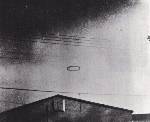
Plate 32: Ft. Belvoir Photo 1
Click on Thumbnail to see Full-size image.
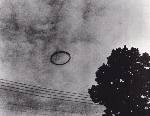
Plate 33: Ft. Belvoir Photo 2
Click on Thumbnail to see Full-size image.
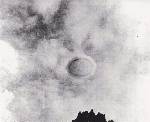
Plate 34: Ft. Belvoir Photo 3
Click on Thumbnail to see Full-size image.

Figure 5: Mosaic of Photos
Click on Thumbnail to see Full-size image.
Table 4
Inclination vs. Altitude
Photo
Inclination
Altitude
Pitch Angle
1
19.9°
16°
4°
2
42.0
31
11
3
46.8
47
0
4
48.1
48
0
5
49.0
49
0
6
49.1
51
2
sin Delta
sin Alpha=
D
Z
Table 5
D
Z=
sin Delta
sin Alpha
Photo
sin Delta
sin Alpha
1
.181
2
.170
3
.141
4
.147
5
.146
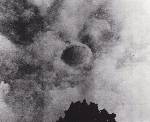
Plate 35: Ft. Belvoir Photo 4
Click on Thumbnail to see Full-size image.

Plate 36: Ft. Belvoir Photo 5
Click on Thumbnail to see Full-size image.
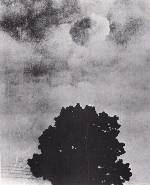
Plate 37: Ft. Belvoir Photo 6
Click on Thumbnail to see Full-size image.

Figure 6: Ft Belvoir Map
Click on Thumbnail to see Full-size image.
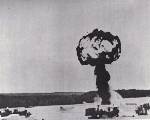
Plate 38: Ft. Belvoir A-Bomb Simulation
Click on Thumbnail to see Full-size image.
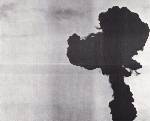
Plate 39: Ft. Belvoir Mushroom Cloud
Click on Thumbnail to see Full-size image.

Plate 40: Ft. Belvoir Vortex Ring
Click on Thumbnail to see Full-size image.